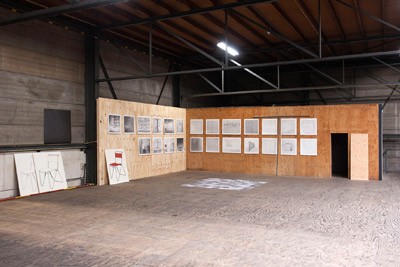florette dijkstra
Florette Dijkstra (The Hague, 1963) looks for the ‘empty spaces’ in art history. Alongside numerous multi-annual projects, she has created drawings surrounding themes of visual art and literature, including a series on the reflection of man. The works explore that which precedes the creation of a work of art, and that which follows it. Dijkstra sometimes spends years travelling in the footsteps of forgotten characters, narrating her quests in drawings and text.
Florette Dijkstra studied at the Royal Academy for Art and Design in Den Bosch. Since 20121, she has created eight editions of KUNSTWORDTTERUGKUNST, a magazine for thinking through and about art. Previous exhibitions include Amsterdam, Arnhem, St. Ives (GB) and Brussels.
Drawing with foreknowledge
Initially there is nothing: a sheet of white paper, a blank canvas, a block of stone. This is all the artist has to work with. He paints, sketches, chops, chisels and draws. The image contained in the mind of the artist is slowly but surely released from the material. It becomes. And subsequently hangs, lies, is there: a work of art, as a defined, finished ‘thing’. We as viewers look at it as though it was always there, no doubt about it.
The wondrous, near invisible line that meanders between being and not-being, between something and nothing, art and emptiness is a running theme in much of Dijkstra’s work. Across two spaces, on a pre-existing loft with storage space, Florette Dijkstra (1963) displays roughly fifty preciously constructed drawings-with-prehistory. Each attempts to express something of the myth of creation. How do great writers think of their stories? How does a sculpture come into existence? How did it begin? What is the grammar of the image? What moves an artist to work? How is the thinking given shape?
Those who are familiar with Dijkstra’s work, know that she does not stick to a single medium — she writes, publishes a magazine, paints and draws, just as one of her great sources of inspiration: the Belgian abstract artist and publicist Michel Seuphor, who passed away in 1999. Dijkstra’s drawings are built up of hundreds of hatched lines. With those very simple lines, originating from a very simple pencil and meticulously placed, she avoids the occasionally coquettish hand of pictorial art.
With those crisp lines, Dijkstra manages to evoke a world which reveals some of the fragility of the moment of creation within the fragility of the moment of creation itself.
The series of drawings and objects Dijkstra displays in the Noletloodsen, bearing the title Groundfloor, can be roughly divided into three themes. They depict the studies of writers and artists whom Dijkstra admires, and whose footprints she trails, sometimes for years on end, in a process of ever increasing personification. Those writers and artists have in common that they are known — who hasn’t heard of Robert Musil or Fernando Pessoa? — but they never reached superstar status. For that, their work was too thoughtful, their attitude towards the outside world too mistrusting or simply shy, their work too unfashionable. Dijkstra attempts to express a hint of the mental exhilaration that seizes writers during or prior to the working process in her ‘writing chambers’.
The second series of drawings is continued in the dark. Here, several children’s’ drawings and a set of cave paintings form an ‘exhibition’ dealing with cause and effect. The third series shows basic shapes within art. This may sound boring, but it is not, for basic shapes are like building blocks, forming the beginning of the process of creation, the syntax of the image. To Dijkstra, these basic shapes are a circle, a rectangle, a line, often made by admired art historical predecessors .
One may recognise the Endless Column, a statue with which Romanian artist Constantin Brancusi erected a ‘stairway to heaven’ near his birthplace in 1937, as a tribute to the fallen of World War 1. There are drawings inspired by the work of the Italian Arte Povera artist Luciano Fabro. On the floor lies a full-scale reconstruction of Square Piece (1967) by Carl Andre. Also, a giant ‘T’ lights up, by painter Blinky Palermo, a student of Beuys and known for his proud monochromic paintings. In Dijkstra’s drawings, the sharpest and severest of shapes gain a delicacy and vulnerability, as though they might evaporate if you look at them for too long.
The drawings and objects of Groundfloor don’t just form an exposition, but simultaneously form a place of reflection, an atelier, a writing table, the mental interior space of the artist. Here, everything converges, everything is fitted and processed. Dijkstra’s drawings evoke images of former times, when winters still covered bedroom windows with frost flowers. You breathed against the cold panes, for a moment the ice crystals melted and you could see the outside world clearly. Then, everything nebulised once more.


